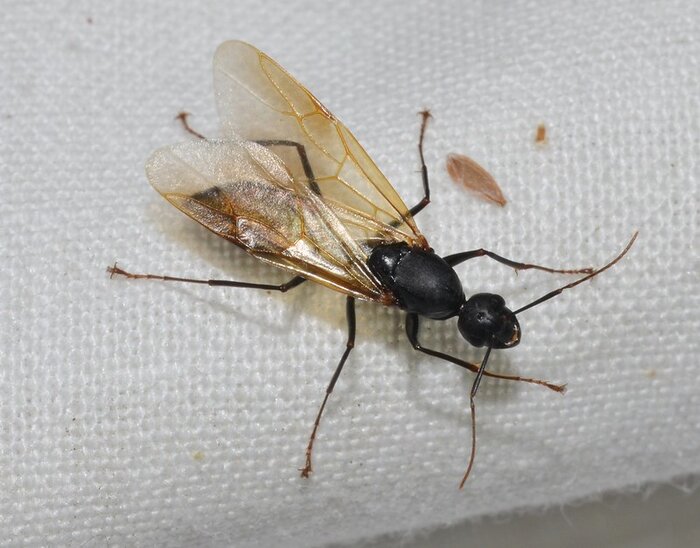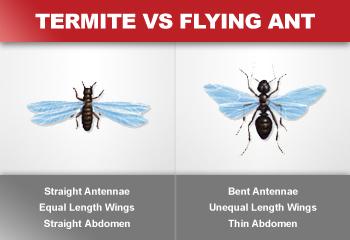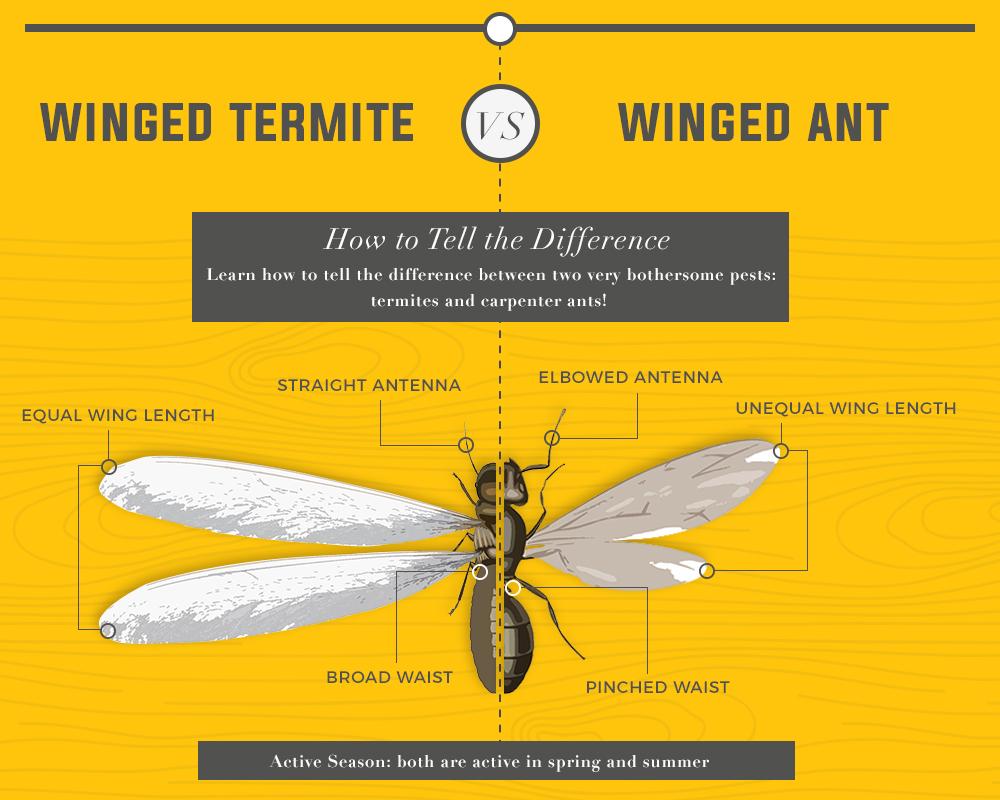Insects That Look Like Flying Ants
For many homeowners, the first obvious sign of termite infestation is a swarm of flying insects. However, not all swarming insects are termites – some are flying ants. Pest control experts are trained to distinguish between flying ants and termites based on a few physical characteristics.
Although ants and termites vary in many ways, it can be hard for people to distinguish between them at first glance. In order to identify either pest, it is crucial to know the differences between them.
What’s the Difference?
Termites have:
-
straight antennae
-
equal length wings
-
straight waist
Flying ants have:
-
bent antennae
-
unequal length wings
-
pinched waist
Appearance Differences
Termites have straight antennae and wide bodies without pinched waists. They are characteristically black or dark brown. Swarmers, or flying termites, have clear front and back wings that are the same length. More about what a termite looks like.
In contrast, ants have elbowed antennae and pinched waists. Their bodies can be black, brown, or reddish. Flying ants have two pairs of brown-tinted wings that differ in size.
Behavior Differences
Both ants and termites live in large colonies with designated caste systems. Termites can be found in decaying trees, stumps, wood debris, lumber, and the wooden members of a structure. Some ants, like carpenter ants, also inhabit wood and the wooden parts of structures. Termites can cause serious structural damage since they eat the wood, while carpenter ants do not eat wood and thus generally do not cause structural damage.
Diet Differences
The diets of these two pests differ, as ants are omnivores and termites feed on cellulose, which is a nutrient-rich material found in plants. Ants primarily eat nectar, seeds, other insects, and food debris found around and inside homes. On the other hand, termites consume mainly wood, paper, and other cellulose-based products.
Life Cycle Differences
Ants go through four stages of development: egg, larva, pupa, and adult. Worker ants live for a few months, while queens can live for years. In contrast, the termite life cycle includes egg, nymph (larvae), and adult phases. Most termites survive for a couple years, while termite queens may live for decades.
Both types of pests have similar reproductive cycles. During warm months, fertile winged ants and termites fly from their nests to mate and establish new colonies. In ant species, the male partners typically die after mating with the females. After termites mate, both male and female partners live on and continue to expand their new colonies. Both ants and termites lose their wings after mating.
Insects That Look Like Flying Ants
The insect world is a vast and complex place, filled with many creatures that are both similar and different from one another. Here are some facts about ants with wings, which are not actually ants at all.
Difference 1: Ants have antennae, while insects with wings do not.
Difference 2: Ants have six legs, while insects with wings have four.
Difference 3: Ants are social creatures that live in colonies, while insects with wings are solitary creatures that live alone.
Ants can be distinguished by their large heads and tiny waists, whereas insects with wings have small heads and huge abdomens—often so big that they can’t walk straight! Their bodies are covered in thick hairs that help them blend into their surroundings so predators can’t find them; when threatened, they emit a foul odor from their rear ends as a defense mechanism.
Ants with wings are actually insects, not ants. They’re called winged ants, and they’re a subspecies of the ant that has lost its wings.
Winged ants can be differentiated by their tiny size (they’re only about 1/2 inch long), as well as their brownish-black skin and four red eyes. They also have six legs, but only two of them are functional for walking—the other four are used for grabbing things like prey or food sources. The texture of their body is very smooth and shiny, which helps them stay clean in wet environments.
These insects are found almost everywhere on Earth except for Antarctica and Greenland.
List Of Insects That Look Like Flying Ants
- Attracts & Kills – Kills common household ants including acrobat, crazy, ghost, little black, odorous house, pavement, and other sweet-eating ants
- Kills the Ants You See & the Ones You Don’t – As worker ants discover the bait, they share it with the rest of the colony to eliminate them all
- Works Fast – You should see a significant decrease in the number of ants visiting the bait stations within just a few days
- Ready to Use – Place the bait stations, watch it attract ants, and eliminate the entire colony
- Use Throughout Your Home – Place stations near areas where you’ve seen ant activity including along baseboards, in corners, on counters, and more
Additional Info :
| Item Dimensions | |
| Height | 4.5 Inches |
| Width | 6.6 Inches |
| Length | 1.2 Inches |
| Weight | 0.27 Pounds |
- Safe
- Extra Concentrated for Long-Lasting Protection
- Natural Ingredients Proven Effective in the Real World
- Large 16oz Bottle
- Powerful Essential Oil
Additional Info :
| Item Dimensions | |
| Weight | 1 Pounds |
- Ortho Home Defense Insect Killer for Indoor & Perimeter2 with Comfort Wand kills ants, cockroaches, spiders, fleas, ticks and other listed bugs; the formula is odor free, won’t stain, and keeps listed bugs out
- KILLS BUGS INSIDE: Kills those annoying home-invading insects, including ants, cockroaches, spiders, fleas, ticks, scorpions, beetles, silverfish, centipedes and millipedes
- KEEPS BUGS OUTSIDE: Creates a bug barrier that will kill bugs you have and prevents new bugs for up to 12 months (applies to ants, roaches and spiders indoors on non-porous surfaces)
- NO STAINING OR STINK: This spray can be used indoors and out, leaves no residue, and has no odor; people and pets may re-enter treated areas after spray has dried
- WAND MAKES APPLICATION EASY: The Comfort Wand eliminates hand fatigue, and there’s no pumping required, making it easy to spray along your home’s perimeter–indoors and outside
Additional Info :
| Color | White |
| Item Dimensions | |
| Height | 4.88 Inches |
| Width | 12 Inches |
| Length | 8.95 Inches |
| Weight | 0.73 Pounds |
- Raid Multi Insect Spray kills bugs on contact
- Kills: Ants, Asian Lady Beetles, Boxelder Bugs, Carpet Beetles, Crickets, Firebrats, Fleas, Silverfish, Flies, Fruit Flies, Non-Biting Gnats, Hornets, Mosquitoes, Moths, Pillbugs, Roaches, Sow Bugs, Spiders** (except Black Widow and Brown Recluse Spiders), Wasps, and Waterbugs
- Insect spray with no lingering chemical odor
- This easy-to-use bug killer can be used indoors or outdoors. Apply where ants, roaches, spiders, flies, and other listed bugs may be infesting
- Repeat application of insect killer as often as necessary for best results
Additional Info :
| Item Dimensions | |
| Height | 9.72 Inches |
| Width | 2.7 Inches |
| Length | 2.7 Inches |
| Weight | 1.21 Pounds |
| Release Date | 2019-02-04T00:00:01Z |
- Triple trapping power, first the UV light attracts the bug then the fan sucks it in and the sticky glue boards trap it. No Zapper.
- Subtle and stylish fruit fly, gnat and mosquito killer, no more ugly traps, easily place in your home, kitchen or office as a decorative, stylish piece.
- Trap indoors, close to insect-ridden fruit, plants or trash bin, turn off lights for best results.
- Not effective on house flies.
- Easy to use, choose between standard or low speed setting and leave it to work its magic, EPA Est. Numb.:93372-CHN-1
Additional Info :
| Color | Black |
| Item Dimensions | |
| Height | 9.1 Inches |
| Width | 5.5 Inches |
| Length | 5.5 Inches |







